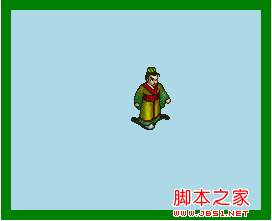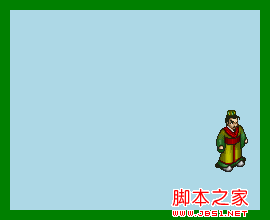 Web Front-end
Web Front-end
 JS Tutorial
JS Tutorial
 Component development of 'Three Kingdoms Cao Cao' in javascript game development (2) Realization of character walking_javascript skills
Component development of 'Three Kingdoms Cao Cao' in javascript game development (2) Realization of character walking_javascript skills
Component development of 'Three Kingdoms Cao Cao' in javascript game development (2) Realization of character walking_javascript skills
In the last lecture, we talked about how to make static characters dynamic. Today we will talk about how to make characters move. Because this lecture involves the content of the previous lecture, I wrote the link to the previous lecture below:
1. Picture preparation
Today I am going to change some pictures to make them fresher.



These materials still come from "The Biography of Cao Cao in the Three Kingdoms". If I remember correctly, they should be Cao Cao's materials. Next, I will combine the techniques from the last time to tell you how to make the characters move. But today we focus on how to make characters move, because we have already talked about how to make characters move from static to dynamic in the previous lecture.
2. Code explanation
First look at the overall javascript code:var moveLengthLeft = 0;
var moveLengthTop = 0;
var actionST = 0;
var timeInterval = 150;
var pic = 0;
function action()
{
var pic1 = "./pic2.png";
var pic2 = "./pic3.png";
var pic3 = "./pic1.png";
var actionArray = [pic1, pic2, pic3];
var doc = document.getElementById("ID_IMG_CAOCAO");
if (pic == actionArray.length - 2){
pic = 0;
}else{
pic = 1;
}
if(pic > 2) {
pic = 2;
doc.src = "./pic1.png"
}
doc.src = actionArray[pic];
}
function walk()
{
setInterval(action, timeInterval);
for(var i = 0; i < 100; i ){
$("#ID_IMG_CAOCAO") .animate({marginLeft: moveLengthLeft}, 10, function(){ //Use animate in jquery to control the character's walking
actionST ;
if(actionST == 100){
standCaocao( );
}
}); // Call the callback when the animation is completed. You can put functions in callback.
$("#ID_IMG_CAOCAO").animate({marginTop: moveLengthTop}, 10);
moveLengthLeft = 2;
moveLengthTop = 1;
}
}
function standCaocao()
{
pic = 2;
}
The local analysis is as follows:
function action()
{
var pic1 = "./pic2.png";
var pic2 = "./pic3.png";
var pic3 = "./pic1.png";
var actionArray = [pic1, pic2, pic3];
var doc = document .getElementById("ID_IMG_CAOCAO");
if (pic == actionArray.length - 2){
pic = 0;
}else{
pic = 1;
}
if(pic > 2){
pic = 2;
doc.src = "./pic1.png"
}
doc.src = actionArray [pic];
}
I have already mentioned the above code in the previous lecture, so I won’t go into it today and will just talk about how to move the character.
First of all, making objects move undoubtedly requires jquery. Yes, today we are going to use one of its functions: animate.
Look at the code again:
function walk ()
{
setInterval(action, timeInterval);
for(var i = 0; i < 100; i ){
$("#ID_IMG_CAOCAO").animate( {marginLeft: moveLengthLeft}, 10, function(){ //Use animate in jquery to control the character's walking
actionST ;
if(actionST == 100){
standCaocao();
}
}); // Call callback when the animation is completed. You can put functions in callback.
$("#ID_IMG_CAOCAO").animate({marginTop: moveLengthTop}, 10);
moveLengthLeft = 2;
moveLengthTop = 1;
}
}
These codes can realize the movement and stopping of characters mainly in callback and animate. Callback mainly makes the character stop, and animate mainly makes the character move.
Usually, the syntax of animate is: animate({change of css code}, time to complete, callback);. For details, please see: http://www.jb51.net/w3school/jquery/jquery_effects.htm. There are many other jquery functions here, you can learn more about them.
Of course, animate is obvious, but what about callback? ? ? It turns out it's hidden inside animate.
function(){ //Use animate in jquery to control character walking
actionST;
if(actionST == 100){
standCaocao();
}
}); // Call the callback when the animation is completed. You can put functions in callback.
This code is the callback. It's just that we put his position in the function, so it's not very visible.
Some tutorials on callback: http://www.jb51.net/w3school/jquery/jquery_callback.htm
There is also a string of code:
function standCaocao()
{
pic = 2;
}
This code is mainly used to turn dynamic characters into static characters. After this movement stops, the character's movements disappear.
Source code download: (includes a jquery-1.8.0.js file)
3. Demonstration effect
The first is:

Then:

Finally:

Demo location
4. Postscript
First of all, character walking and movement are essential aspects of game production. Choosing good algorithms and functions is the key to success.
Next time we will study how to use js to imitate the plot dialogue of the characters in "The Legend of Cao Cao" in "Three Kingdoms". Stay tuned!
I hope you will support me more, thank you. I will repay everyone with better articles.

Hot AI Tools

Undresser.AI Undress
AI-powered app for creating realistic nude photos

AI Clothes Remover
Online AI tool for removing clothes from photos.

Undress AI Tool
Undress images for free

Clothoff.io
AI clothes remover

Video Face Swap
Swap faces in any video effortlessly with our completely free AI face swap tool!

Hot Article

Hot Tools

Notepad++7.3.1
Easy-to-use and free code editor

SublimeText3 Chinese version
Chinese version, very easy to use

Zend Studio 13.0.1
Powerful PHP integrated development environment

Dreamweaver CS6
Visual web development tools

SublimeText3 Mac version
God-level code editing software (SublimeText3)

Hot Topics
 1662
1662
 14
14
 1419
1419
 52
52
 1313
1313
 25
25
 1262
1262
 29
29
 1235
1235
 24
24
 Demystifying JavaScript: What It Does and Why It Matters
Apr 09, 2025 am 12:07 AM
Demystifying JavaScript: What It Does and Why It Matters
Apr 09, 2025 am 12:07 AM
JavaScript is the cornerstone of modern web development, and its main functions include event-driven programming, dynamic content generation and asynchronous programming. 1) Event-driven programming allows web pages to change dynamically according to user operations. 2) Dynamic content generation allows page content to be adjusted according to conditions. 3) Asynchronous programming ensures that the user interface is not blocked. JavaScript is widely used in web interaction, single-page application and server-side development, greatly improving the flexibility of user experience and cross-platform development.
 The Evolution of JavaScript: Current Trends and Future Prospects
Apr 10, 2025 am 09:33 AM
The Evolution of JavaScript: Current Trends and Future Prospects
Apr 10, 2025 am 09:33 AM
The latest trends in JavaScript include the rise of TypeScript, the popularity of modern frameworks and libraries, and the application of WebAssembly. Future prospects cover more powerful type systems, the development of server-side JavaScript, the expansion of artificial intelligence and machine learning, and the potential of IoT and edge computing.
 JavaScript Engines: Comparing Implementations
Apr 13, 2025 am 12:05 AM
JavaScript Engines: Comparing Implementations
Apr 13, 2025 am 12:05 AM
Different JavaScript engines have different effects when parsing and executing JavaScript code, because the implementation principles and optimization strategies of each engine differ. 1. Lexical analysis: convert source code into lexical unit. 2. Grammar analysis: Generate an abstract syntax tree. 3. Optimization and compilation: Generate machine code through the JIT compiler. 4. Execute: Run the machine code. V8 engine optimizes through instant compilation and hidden class, SpiderMonkey uses a type inference system, resulting in different performance performance on the same code.
 JavaScript: Exploring the Versatility of a Web Language
Apr 11, 2025 am 12:01 AM
JavaScript: Exploring the Versatility of a Web Language
Apr 11, 2025 am 12:01 AM
JavaScript is the core language of modern web development and is widely used for its diversity and flexibility. 1) Front-end development: build dynamic web pages and single-page applications through DOM operations and modern frameworks (such as React, Vue.js, Angular). 2) Server-side development: Node.js uses a non-blocking I/O model to handle high concurrency and real-time applications. 3) Mobile and desktop application development: cross-platform development is realized through ReactNative and Electron to improve development efficiency.
 Python vs. JavaScript: The Learning Curve and Ease of Use
Apr 16, 2025 am 12:12 AM
Python vs. JavaScript: The Learning Curve and Ease of Use
Apr 16, 2025 am 12:12 AM
Python is more suitable for beginners, with a smooth learning curve and concise syntax; JavaScript is suitable for front-end development, with a steep learning curve and flexible syntax. 1. Python syntax is intuitive and suitable for data science and back-end development. 2. JavaScript is flexible and widely used in front-end and server-side programming.
 How to Build a Multi-Tenant SaaS Application with Next.js (Frontend Integration)
Apr 11, 2025 am 08:22 AM
How to Build a Multi-Tenant SaaS Application with Next.js (Frontend Integration)
Apr 11, 2025 am 08:22 AM
This article demonstrates frontend integration with a backend secured by Permit, building a functional EdTech SaaS application using Next.js. The frontend fetches user permissions to control UI visibility and ensures API requests adhere to role-base
 From C/C to JavaScript: How It All Works
Apr 14, 2025 am 12:05 AM
From C/C to JavaScript: How It All Works
Apr 14, 2025 am 12:05 AM
The shift from C/C to JavaScript requires adapting to dynamic typing, garbage collection and asynchronous programming. 1) C/C is a statically typed language that requires manual memory management, while JavaScript is dynamically typed and garbage collection is automatically processed. 2) C/C needs to be compiled into machine code, while JavaScript is an interpreted language. 3) JavaScript introduces concepts such as closures, prototype chains and Promise, which enhances flexibility and asynchronous programming capabilities.
 Building a Multi-Tenant SaaS Application with Next.js (Backend Integration)
Apr 11, 2025 am 08:23 AM
Building a Multi-Tenant SaaS Application with Next.js (Backend Integration)
Apr 11, 2025 am 08:23 AM
I built a functional multi-tenant SaaS application (an EdTech app) with your everyday tech tool and you can do the same. First, what’s a multi-tenant SaaS application? Multi-tenant SaaS applications let you serve multiple customers from a sing



